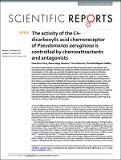Por favor, use este identificador para citar o enlazar a este item:
http://hdl.handle.net/10261/167591COMPARTIR / EXPORTAR:
 SHARE SHARE
 CORE
BASE CORE
BASE
|
|
| Visualizar otros formatos: MARC | Dublin Core | RDF | ORE | MODS | METS | DIDL | DATACITE | |

| Título: | The activity of the C4-dicarboxylic acid chemoreceptor of Pseudomonas aeruginosa is controlled by chemoattractants and antagonists |
Autor: | Martín-Mora, David CSIC ORCID; Ortega, Álvaro; Pérez-Maldonado, Francisco J.; Krell, Tino CSIC ORCID; Matilla, Miguel A. CSIC ORCID | Fecha de publicación: | 2018 | Editor: | Nature Publishing Group | Citación: | Scientific Reports 8 (2018) | Resumen: | Chemotaxis toward organic acids has been associated with colonization fitness and virulence and the opportunistic pathogen Pseudomonas aeruginosa exhibits taxis toward several tricarboxylic acid intermediates. In this study, we used high-throughput ligand screening and isothermal titration calorimetry to demonstrate that the ligand binding domain (LBD) of the chemoreceptor PA2652 directly recognizes five C4-dicarboxylic acids with K values ranging from 23 μM to 1.24 mM. In vivo experimentation showed that three of the identified ligands act as chemoattractants whereas two of them behave as antagonists by inhibiting the downstream chemotaxis signalling cascade. In vitro and in vivo competition assays showed that antagonists compete with chemoattractants for binding to PA2652-LBD, thereby decreasing the affinity for chemoattractants and the subsequent chemotactic response. Two chemosensory pathways encoded in the genome of P. aeruginosa, che and che2, have been associated to chemotaxis but we found that only the che pathway is involved in PA2652-mediated taxis. The receptor PA2652 is predicted to contain a sCACHE LBD and analytical ultracentrifugation analyses showed that PA2652-LBD is dimeric in the presence and the absence of ligands. Our results indicate the feasibility of using antagonists to interfere specifically with chemotaxis, which may be an alternative strategy to fight bacterial pathogens. | URI: | http://hdl.handle.net/10261/167591 | DOI: | 10.1038/s41598-018-20283-7 | Identificadores: | doi: 10.1038/s41598-018-20283-7 issn: 2045-2322 |
| Aparece en las colecciones: | (EEZ) Artículos |
Ficheros en este ítem:
| Fichero | Descripción | Tamaño | Formato | |
|---|---|---|---|---|
| 2018_Martin_SR.pdf | 1,99 MB | Adobe PDF |  Visualizar/Abrir |
CORE Recommender
PubMed Central
Citations
22
checked on 22-abr-2024
SCOPUSTM
Citations
28
checked on 24-abr-2024
WEB OF SCIENCETM
Citations
28
checked on 29-feb-2024
Page view(s)
243
checked on 24-abr-2024
Download(s)
200
checked on 24-abr-2024

